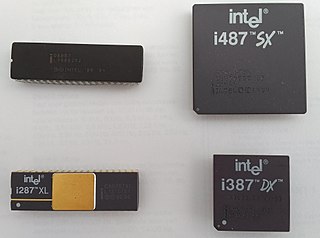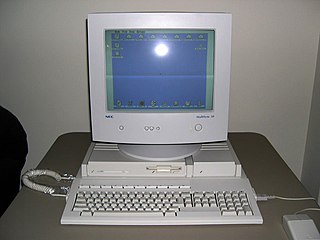
The Motorola 68000 is a 16/32-bit complex instruction set computer (CISC) microprocessor, introduced in 1979 by Motorola Semiconductor Products Sector.

The Motorola 68020 is a 32-bit microprocessor from Motorola, released in 1984. A lower-cost version was also made available, known as the 68EC020. In keeping with naming practices common to Motorola designs, the 68020 is usually referred to as the "020", pronounced "oh-two-oh" or "oh-twenty".

The Motorola 68030 ("sixty-eight-oh-thirty") is a 32-bit microprocessor in the Motorola 68000 family. It was released in 1987. The 68030 was the successor to the Motorola 68020, and was followed by the Motorola 68040. In keeping with general Motorola naming, this CPU is often referred to as the 030.

The Motorola 68040 ("sixty-eight-oh-forty") is a 32-bit microprocessor in the Motorola 68000 series, released in 1990. It is the successor to the 68030 and is followed by the 68060, skipping the 68050. In keeping with general Motorola naming, the 68040 is often referred to as simply the '040.

The Motorola 68060 ("sixty-eight-oh-sixty") is a 32-bit microprocessor from Motorola released in 1994. It is the successor to the Motorola 68040 and is the highest performing member of the 68000 series. Two derivatives were produced, the 68LC060 and the 68EC060.
The NS32000, sometimes known as the 32k, is a series of microprocessors produced by National Semiconductor. The first member of the family came to market in 1982, briefly known as the 16032 before becoming the 32016. It was the first general-purpose microprocessor on the market that used 32-bit data throughout: the Motorola 68000 used 32-bit data but had a 16-bit ALU and thus took twice as long perform many operations. However, the 32016 contained many bugs and often could not be run at its rated speed. These problems, and the presence of the otherwise similar 68000 which had been available since 1980, led to little use in the market.

A floating-point unit is a part of a computer system specially designed to carry out operations on floating-point numbers. Typical operations are addition, subtraction, multiplication, division, and square root. Some FPUs can also perform various transcendental functions such as exponential or trigonometric calculations, but the accuracy can be low, so some systems prefer to compute these functions in software.
The 88000 is a RISC instruction set architecture developed by Motorola during the 1980s. The MC88100 arrived on the market in 1988, some two years after the competing SPARC and MIPS. Due to the late start and extensive delays releasing the second-generation MC88110, the m88k achieved very limited success outside of the MVME platform and embedded controller environments. When Motorola joined the AIM alliance in 1991 to develop the PowerPC, further development of the 88000 ended.
The Motorola 68000 series is a family of 32-bit complex instruction set computer (CISC) microprocessors. During the 1980s and early 1990s, they were popular in personal computers and workstations and were the primary competitors of Intel's x86 microprocessors. They were best known as the processors used in the early Apple Macintosh, the Sharp X68000, the Commodore Amiga, the Sinclair QL, the Atari ST and Falcon, the Atari Jaguar, the Sega Genesis, the Philips CD-i, the Capcom System I (Arcade), the AT&T UNIX PC, the Tandy Model 16/16B/6000, the Sun Microsystems Sun-1, Sun-2 and Sun-3, the NeXT Computer, NeXTcube, NeXTstation, and NeXTcube Turbo, early Silicon Graphics IRIS workstations, computers from MASSCOMP, the Texas Instruments TI-89/TI-92 calculators, the Palm Pilot, the Control Data Corporation CDCNET Device Interface, and the Space Shuttle. Although no modern desktop computers are based on processors in the 680x0 series, derivative processors are still widely used in embedded systems.

The Amiga 3000, or A3000, is a personal computer released by Commodore in June 1990. It is the successor to the Amiga 2000 and its upgraded model Amiga 2500 with more processing speed, improved graphics, and a new revision of the operating system.

The Amiga 2000, or A2000, is a personal computer released by Commodore in March 1987. It was introduced as a "big box" expandable variant of the Amiga 1000 but quickly redesigned to share most of its electronic components with the contemporary Amiga 500 for cost reduction. Expansion capabilities include two 3.5" drive bays and one 5.25" bay that could be used by a 5.25" floppy drive, a hard drive, or CD-ROM once they became available.

The Macintosh IIx is a personal computer designed, manufactured, and sold by Apple Computer from September 1988 to October 1990. This model was introduced as an update to the original Macintosh II, replacing the 16 MHz Motorola 68020 CPU and 68881 FPU with a 68030 CPU and 68882 FPU running at the same clock speed. The initial price of the IIx was US$7,769 or US$9,369 for the version with a 40 MB hard drive.

A coprocessor is a computer processor used to supplement the functions of the primary processor. Operations performed by the coprocessor may be floating-point arithmetic, graphics, signal processing, string processing, cryptography or I/O interfacing with peripheral devices. By offloading processor-intensive tasks from the main processor, coprocessors can accelerate system performance. Coprocessors allow a line of computers to be customized, so that customers who do not need the extra performance do not need to pay for it.

The Atari Falcon030, released in 1992, is the final personal computer from Atari Corporation. A high-end model of the Atari ST line, the machine is based on a Motorola 68030 CPU and a Motorola 56001 digital signal processor, which distinguishes it from most other microcomputers of the era. It includes a new VIDEL programmable graphics system which greatly improves graphics capabilities.

The NXP ColdFire is a microprocessor that derives from the Motorola 68000 family architecture, manufactured for embedded systems development by NXP Semiconductors. It was formerly manufactured by Freescale Semiconductor which merged with NXP in 2015.

The Atari TT030 is a member of the Atari ST family, released in 1990. It was originally intended to be a high-end Unix workstation, but Atari took two years to release a port of Unix SVR4 for the TT, which prevented the TT from ever being seriously considered in its intended market.
x87 is a floating-point-related subset of the x86 architecture instruction set. It originated as an extension of the 8086 instruction set in the form of optional floating-point coprocessors that work in tandem with corresponding x86 CPUs. These microchips have names ending in "87". This is also known as the NPX. Like other extensions to the basic instruction set, x87 instructions are not strictly needed to construct working programs, but provide hardware and microcode implementations of common numerical tasks, allowing these tasks to be performed much faster than corresponding machine code routines can. The x87 instruction set includes instructions for basic floating-point operations such as addition, subtraction and comparison, but also for more complex numerical operations, such as the computation of the tangent function and its inverse, for example.

The R5000 is a 64-bit, bi-endian, superscalar, in-order execution 2-issue design microprocessor, that implements the MIPS IV instruction set architecture (ISA) developed by Quantum Effect Design (QED) in 1996. The project was funded by MIPS Technologies, Inc (MTI), also the licensor. MTI then licensed the design to Integrated Device Technology (IDT), NEC, NKK, and Toshiba. The R5000 succeeded the QED R4600 and R4700 as their flagship high-end embedded microprocessor. IDT marketed its version of the R5000 as the 79RV5000, NEC as VR5000, NKK as the NR5000, and Toshiba as the TX5000. The R5000 was sold to PMC-Sierra when the company acquired QED. Derivatives of the R5000 are still in production today for embedded systems.
The Intel 8231 and 8232 were early designs of floating-point maths coprocessors (FPUs), marketed for use with their i8080 line of primary CPUs. They were licensed versions of AMD's Am9511 and Am9512 FPUs, from 1977 and 1979, themselves claimed by AMD as the world's first single-chip FPU solutions.
















